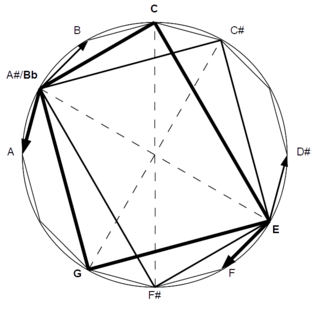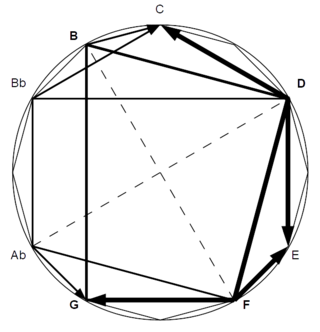
Jazz guitar may refer to either a type of electric guitar or a guitar playing style in jazz, using electric amplification to increase the volume of acoustic guitars.

In music performances, rhythm guitar is a technique and role that performs a combination of two functions: to provide all or part of the rhythmic pulse in conjunction with other instruments from the rhythm section ; and to provide all or part of the harmony, i.e. the chords from a song's chord progression, where a chord is a group of notes played together. Therefore, the basic technique of rhythm guitar is to hold down a series of chords with the fretting hand while strumming or fingerpicking rhythmically with the other hand. More developed rhythm techniques include arpeggios, damping, riffs, chord solos, and complex strums.
The 12-bar blues is one of the most prominent chord progressions in popular music. The blues progression has a distinctive form in lyrics, phrase, chord structure, and duration. In its basic form, it is predominantly based on the I, IV, and V chords of a key. Mastery of the blues and rhythm changes are "critical elements for building a jazz repertoire".
In a musical composition, a chord progression or harmonic progression is a succession of chords. Chord progressions are the foundation of harmony in Western musical tradition from the common practice era of Classical music to the 21st century. Chord progressions are the foundation of popular music styles, traditional music, as well as genres such as blues and jazz. In these genres, chord progressions are the defining feature on which melody and rhythm are built.
A secondary chord is an analytical label for a specific harmonic device that is prevalent in the tonal idiom of Western music beginning in the common practice period: the use of diatonic functions for tonicization.

In music, extended chords are certain chords or triads with notes extended, or added, beyond the seventh. Ninth, eleventh, and thirteenth chords are extended chords. The thirteenth is the farthest extension diatonically possible as, by that point, all seven tonal degrees are represented within the chord. In practice however, extended chords do not typically use all the chord members; when it is not altered, the fifth is often omitted, as are notes between the seventh and the highest note, unless they are altered to give a special texture.
In jazz, comping is the chords, rhythms, and countermelodies that keyboard players, guitar players, or drummers use to support a musician's improvised solo or melody lines. It is also the action of accompanying, and the left-hand part of a solo pianist.
Coltrane changes are a harmonic progression variation using substitute chords over common jazz chord progressions. These substitution patterns were first demonstrated by jazz musician John Coltrane on the albums Bags & Trane and Cannonball Adderley Quintet in Chicago. Coltrane continued his explorations on the 1960 album Giant Steps and expanded on the substitution cycle in his compositions "Giant Steps" and "Countdown", the latter of which is a reharmonized version of Eddie Vinson's "Tune Up". The Coltrane changes are a standard advanced harmonic substitution used in jazz improvisation.
Song structure is the arrangement of a song, and is a part of the songwriting process. It is typically sectional, which uses repeating forms in songs. Common forms include bar form, 32-bar form, verse–chorus form, ternary form, strophic form, and the 12-bar blues. Popular music songs traditionally use the same music for each verse or stanza of lyrics. Pop and traditional forms can be used even with songs that have structural differences in melodies. The most common format in modern popular music is introduction (intro), verse, pre-chorus, chorus, verse, pre-chorus, chorus, bridge, and chorus. In rock music styles, notably heavy metal music, there is usually one or more guitar solos in the song, often found after the middle chorus part. In pop music, there may be a guitar solo, or a solo performed with another instrument such as a synthesizer or a saxophone.

In music theory, chord substitution is the technique of using a chord in place of another in a progression of chords, or a chord progression. Much of the European classical repertoire and the vast majority of blues, jazz and rock music songs are based on chord progressions. "A chord substitution occurs when a chord is replaced by another that is made to function like the original. Usually substituted chords possess two pitches in common with the triad that they are replacing."

In music, a guitar chord is a set of notes played on a guitar. A chord's notes are often played simultaneously, but they can be played sequentially in an arpeggio. The implementation of guitar chords depends on the guitar tuning. Most guitars used in popular music have six strings with the "standard" tuning of the Spanish classical guitar, namely E–A–D–G–B–E' ; in standard tuning, the intervals present among adjacent strings are perfect fourths except for the major third (G,B). Standard tuning requires four chord-shapes for the major triads.

Jazz harmony is the theory and practice of how chords are used in jazz music. Jazz bears certain similarities to other practices in the tradition of Western harmony, such as many chord progressions, and the incorporation of the major and minor scales as a basis for chordal construction. In jazz, chords are often arranged vertically in major or minor thirds, although stacked fourths are also quite common. Also, jazz music tends to favor certain harmonic progressions and includes the addition of tensions, intervals such as 9ths, 11ths, and 13ths to chords. Additionally, scales unique to style are used as the basis of many harmonic elements found in jazz. Jazz harmony is notable for the use of seventh chords as the basic harmonic unit more often than triads, as in classical music. In the words of Robert Rawlins and Nor Eddine Bahha, "7th chords provide the building blocks of jazz harmony."

In jazz and jazz harmony, the chord progression from iv7 to ♭VII7 to I (the tonic or "home" chord) has been nicknamed the backdoor progression or the backdoor ii-V, as described by jazz theorist and author Jerry Coker. This name derives from an assumption that the normal progression to the tonic, the ii-V-I turnaround (ii-V7 to I, see also authentic cadence) is, by inference, the "front door", a metaphor suggesting that this is the main route to the tonic.

Rhythm changes are a common 32-bar chord progression in jazz, originating as the chord progression for George Gershwin's "I Got Rhythm". The progression is in AABA form, with each A section based on repetitions of the ubiquitous I–vi–ii–V sequence (or variants such as iii–vi–ii–V), and the B section using a circle of fifths sequence based on III7–VI7–II7–V7, a progression which is sometimes given passing chords.

A lead sheet or fake sheet is a form of musical notation that specifies the essential elements of a popular song: the melody, lyrics and harmony. The melody is written in modern Western music notation, the lyric is written as text below the staff and the harmony is specified with chord symbols above the staff.

In jazz, a turnaround is a passage at the end of a section which leads to the next section. This next section is most often the repetition of the previous section or the entire piece or song.
The ii–V–I progression is a common cadential chord progression used in a wide variety of music genres, including jazz harmony. It is a succession of chords whose roots descend in fifths from the second degree (supertonic) to the fifth degree (dominant), and finally to the tonic. In a major key, the supertonic triad (ii) is minor, and in a minor key it is diminished. The dominant is, in its normal form, a major triad and commonly a dominant seventh chord. With the addition of chord alterations, substitutions, and extensions, limitless variations exist on this simple formula.
"All the Things You Are" is a song composed by Jerome Kern with lyrics written by Oscar Hammerstein II.
In music, harmonization is the chordal accompaniment to a line or melody: "Using chords and melodies together, making harmony by stacking scale tones as triads".

In music, the vi–ii–V–I progression is a chord progression. A vi–ii–V–I progression in C major is shown below.

 Play (help·info)
Play (help·info)
 Play (help·info)
Play (help·info)









